werk, bauen + wohnen 10-2019

David against Goliath on the Urban Periphery
In the north and south of Lucerne the laws of the agglomeration prevail, as indeed they do elsewhere. Disparate elements stand arbitrarily beside each other: motorway feeders beside bargain centres, areas of private houses next to shopping centres, traditional businesses beside smart new buildings. The contrasts are harsh, the change is abrupt, formerly important village roads end at the motorway noise protection wall.
At both poles of the richly traditional canton capital a building fever is raging, investors are planning at a pace never seen before. The suburban communities, which only a short time ago saw themselves as rural, now have to deal with major challenges. In the north and south of Lucerne serious efforts are being made to utilise this dynamism so that ordered urban spaces can develop out of the chaotic existing situation. Both here and there squares and street spaces are to be created that improve orientation and offer a quality as a place to stay, and more space is being made for non-motorised traffic.
Here one thing becomes clear: compared with the enormous forces of the market, the assumed constraints of individual traffic, the negotiating weight of investors and the lack of interest of landowners, in their struggle for quality in urban design planners face a tough task – both those who are self-employed and those in the public service. Only by showing tenacity, employing a certain amount of guile and keeping their eyes wide open can they steer developments in the direction they wish. No orders can be given, the political will and the backing for planning are too weak. The economic restraint imposed on local authorities has been a stab in the back for many efforts. — Daniel Kurz, Roland Züger
Nevertheless, it is evident that on Seetalplatz in Emmen, like on Mattenplatz in Kriens, central places with an urban quality as a place to stay are being created and, thanks to more recent plans, the traditional centres of Horw and Kriens are beginning to speak an urban language. To ensure success not only is the right idea at the right time needed, but also patient perseverance in order to direct a process involving important protagonists from a position of powerlessness. This calls for a civil commit-ment from politicians and planners that goes far beyond their official responsibilities.